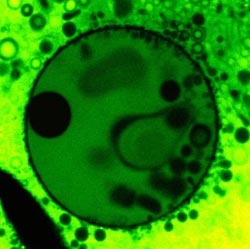Clay-armored bubbles may have formed first protocells

Fatty-acid liposomes compartmentalize inside a clay vesicle. Credit: Photo courtesy of Anand Bala Subramaniam, Harvard School of Engineering and Applied Sciences<br>
A team of applied physicists at Harvard's School of Engineering and Applied Sciences (SEAS), Princeton, and Brandeis have demonstrated the formation of semipermeable vesicles from inorganic clay.
The research, published online this week in the journal Soft Matter, shows that clay vesicles provide an ideal container for the compartmentalization of complex organic molecules.
The authors say the discovery opens the possibility that primitive cells might have formed inside inorganic clay microcompartments.
“A lot of work, dating back several decades, explores the role of air bubbles in concentrating molecules and nanoparticles to allow interesting chemistry to occur,” says lead author Anand Bala Subramaniam, a doctoral candidate at SEAS.
“We have now provided a complete physical mechanism for the transition from a two-phase clay–air bubble system, which precludes any aqueous-phase chemistry, to a single aqueous-phase clay vesicle system,” Subramaniam says, “creating a semipermeable vesicle from materials that are readily available in the environment.”
“Clay-armored bubbles” form naturally when platelike particles of montmorillonite collect on the outer surface of air bubbles under water.
When the clay bubbles come into contact with simple organic liquids like ethanol and methanol, which have a lower surface tension than water, the liquid wets the overlapping plates. As the inner surface of the clay shell becomes wet, the disturbed air bubble inside dissolves.
The resulting clay vesicle is a strong, spherical shell that creates a physical boundary between the water inside and the water outside. The translucent, cell-like vesicles are robust enough to protect their contents in a dynamic, aquatic environment such as the ocean.
Microscopic pores in the vesicle walls create a semipermeable membrane that allows chemical building blocks to enter the “cell,” while preventing larger structures from leaving.
Scientists have studied montmorillonite, an abundant clay, for hundreds of years, and the mineral is known to serve as a chemical catalyst, encouraging lipids to form membranes and single nucleotides to join into strands of RNA.
Because liposomes and RNA would have been essential precursors to primordial life, Subramaniam and his coauthors suggest that the pores in the clay vesicles could do double duty as both selective entry points and catalytic sites.
“The conclusion here is that small fatty acid molecules go in and self-assemble into larger structures, and then they can't come out,” says principal investigator Howard A. Stone, the Dixon Professor in Mechanical and Aerospace Engineering at Princeton, and a former Harvard faculty member. “If there is a benefit to being protected in a clay vesicle, this is a natural way to favor and select for molecules that can self-organize.”
Future research will explore the physical interactions between the platelike clay particles, and between the liquids and the clay. The researchers are also interested to see whether these clay vesicles can, indeed, be found in the natural environment today.
“Whether clay vesicles could have played a significant role in the origins of life is of course unknown,” says Subramaniam, “but the fact that they are so robust, along with the well-known catalytic properties of clay, suggests that they may have had some part to play.”
Subramaniam and Stone's coauthors include Jiandi Wan, of Princeton University, and Arvind Gopinath, of Brandeis University.
The research was funded by the Harvard Materials Research Science and Engineering Center and supported by the Harvard Center for Brain Science Imaging Facility.
Media Contact
More Information:
http://www.harvard.eduAll latest news from the category: Physics and Astronomy
This area deals with the fundamental laws and building blocks of nature and how they interact, the properties and the behavior of matter, and research into space and time and their structures.
innovations-report provides in-depth reports and articles on subjects such as astrophysics, laser technologies, nuclear, quantum, particle and solid-state physics, nanotechnologies, planetary research and findings (Mars, Venus) and developments related to the Hubble Telescope.
Newest articles

Superradiant atoms could push the boundaries of how precisely time can be measured
Superradiant atoms can help us measure time more precisely than ever. In a new study, researchers from the University of Copenhagen present a new method for measuring the time interval,…

Ion thermoelectric conversion devices for near room temperature
The electrode sheet of the thermoelectric device consists of ionic hydrogel, which is sandwiched between the electrodes to form, and the Prussian blue on the electrode undergoes a redox reaction…

Zap Energy achieves 37-million-degree temperatures in a compact device
New publication reports record electron temperatures for a small-scale, sheared-flow-stabilized Z-pinch fusion device. In the nine decades since humans first produced fusion reactions, only a few fusion technologies have demonstrated…





















